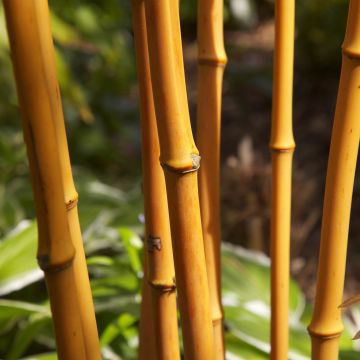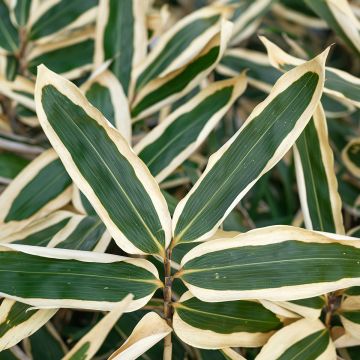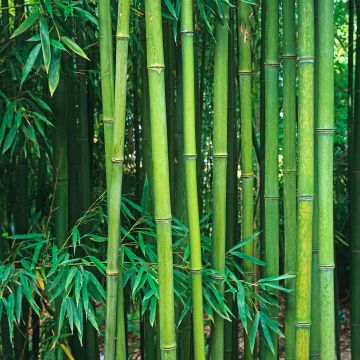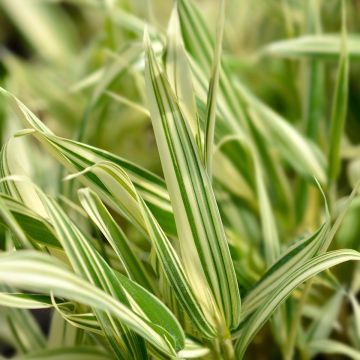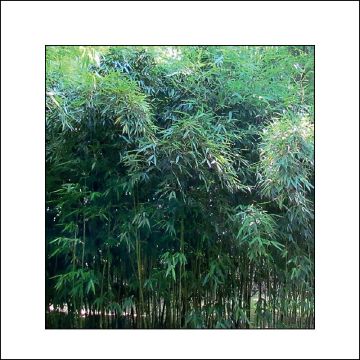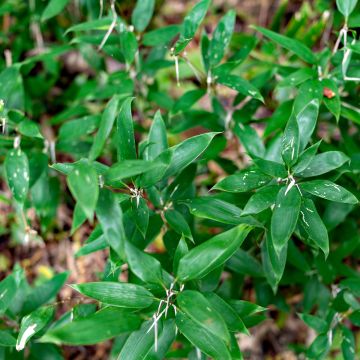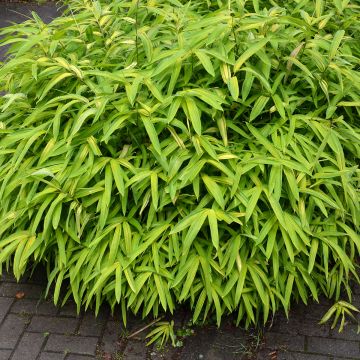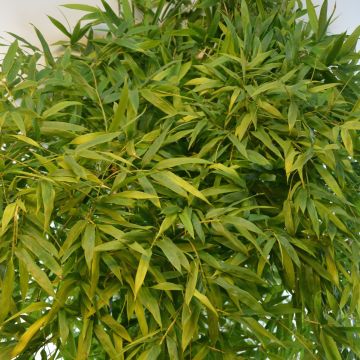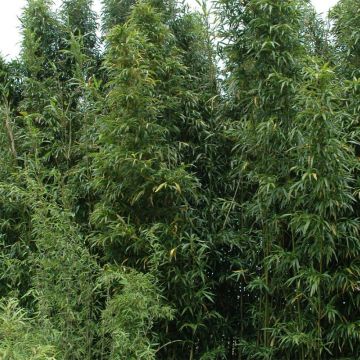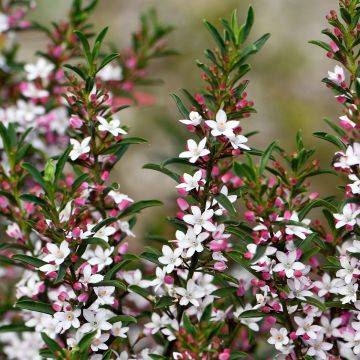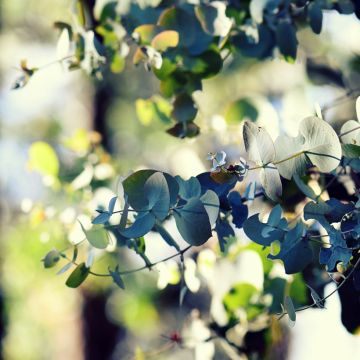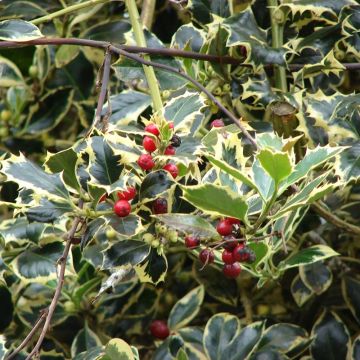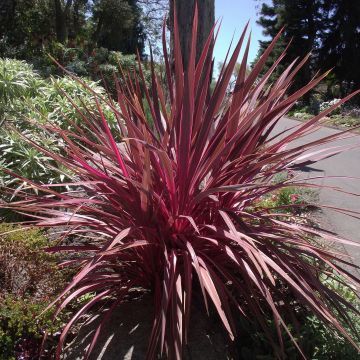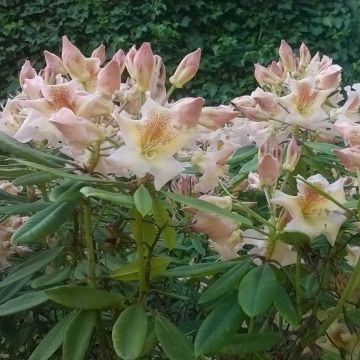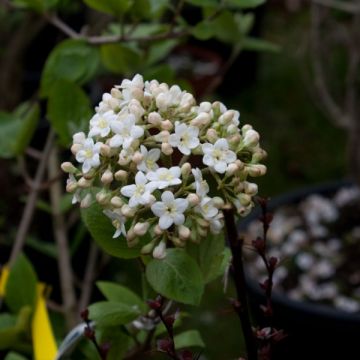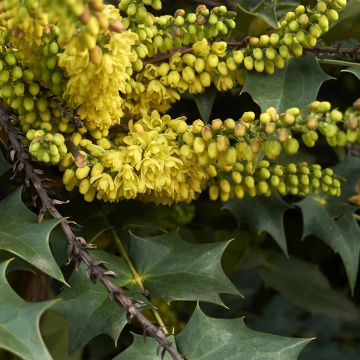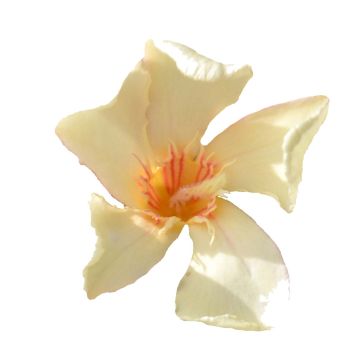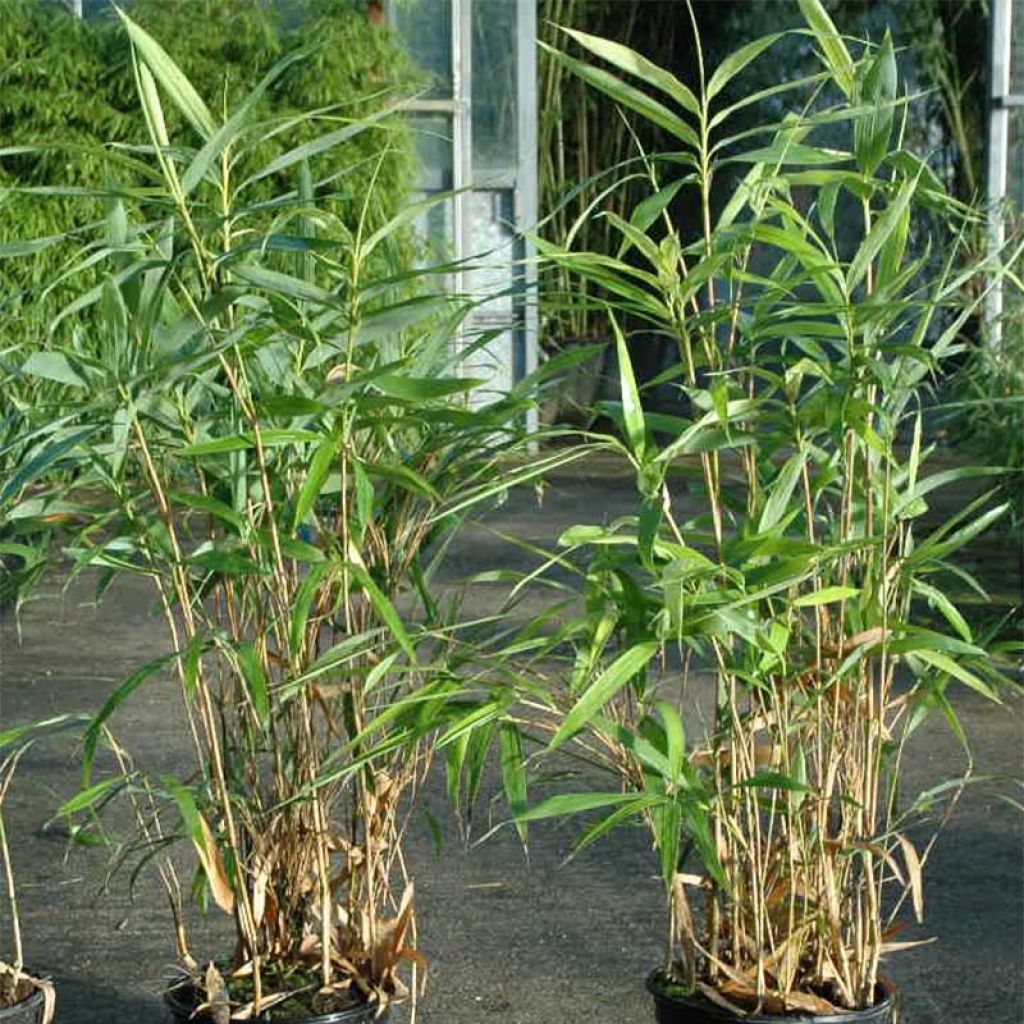

Pseudosasa japonica Tsutsumiana - Arrow Bamboo
Pseudosasa japonica Tsutsumiana - Arrow Bamboo
Pseudosasa japonica Tsutsumiana
Arrow Bamboo
Top
Loic R., 26/10/2022
This item cannot be shipped to the selected country
Delivery charge from €5.90
More information
Schedule delivery date,
and select date in basket
This plant carries a 24 months recovery warranty
More information
We guarantee the quality of our plants for a full growing cycle, and will replace at our expense any plant that fails to recover under normal climatic and planting conditions.
From €5.90 for pickup delivery and €6.90 for home delivery
Express home delivery from €8.90.

Does this plant fit my garden?
Set up your Plantfit profile →
Description
Pseudosasa japonica 'Tsutsumiana' is a medium-sized bamboo that is not only extremely decorative but also easy to grow in any soil and under most of our climates. It is recognized by its straight canes of beautiful olive green, with swollen nodes that resemble shallot bulbs. Its tight clump habit and its abundant foliage of dark green and glossy leaves are other assets of this weakly trailing bamboo that takes its time to reach its full potential. Truly evergreen, it works wonders as a free or trimmed hedge, as an isolated clump in a small garden, or as a stunning focal point in a container on a terrace or balcony. Place it in a semi-shaded or even shaded position, as its foliage dislikes direct sunlight.
Introduced around 1980 in France by F. Picard and F. Martin, Pseudosasa japonica 'Tsutsumiana' is a particularly hardy plant native to Japan, capable of withstanding temperatures as low as -25°C (-13 °F). It belongs to the Poaceae family, and is a type of giant grass with woody stems and weakly trailing rhizomes, which may need to be contained with anti-rhizome barriers. Its growth is very slow, taking several years to reach maturity. It has an upright habit at the base, with a bushy, dense, highly branched and slightly trailing crown. It produces classic-looking canes (or culms) when young, then they swell at the nodes from the second year onwards. The emerald green nodes are topped by an almost black ring, while the cauline sheaths are persistent and beige to orange in colour. At maturity, the culms can measure 1.5 to 3.5cm (0.6 to 1.4in) in diameter and 3 to 4m (9ft 10in to 13ft) in height. The abundant foliage consists of large leaves, glossy dark green in colour, measuring 25cm (9.8in) long and approximately 1.5 to 3cm (0.6 to 1.2in) wide. It is evergreen, but the leaves fall and renew twice a year, mainly in autumn but also in spring.
Undisputed star of Asian-inspired gardens, bamboo suits many styles, from the most contemporary to the most exotic, including natural gardens or water gardens. When planted as a specimen, Pseudosasa japonica 'Tsutsumiana' allows for the creation of beautiful hedges on property boundaries, lush evergreen bouquets when isolated, or opulent pots on the terrace. Its graphics and strong presence bring a lot of character to even the most modest decor, in all our regions. Its density makes it an excellent candidate to form an efficient and elegant privacy screen, especially when planted in fertile and fresh soil. Bamboos blend well together, choose varieties of similar vigor, with culms of different colors. Bamboos are always perfect near water features, as they appreciate the cool atmosphere.
Report an error about the product description
Pseudosasa japonica Tsutsumiana - Arrow Bamboo in pictures
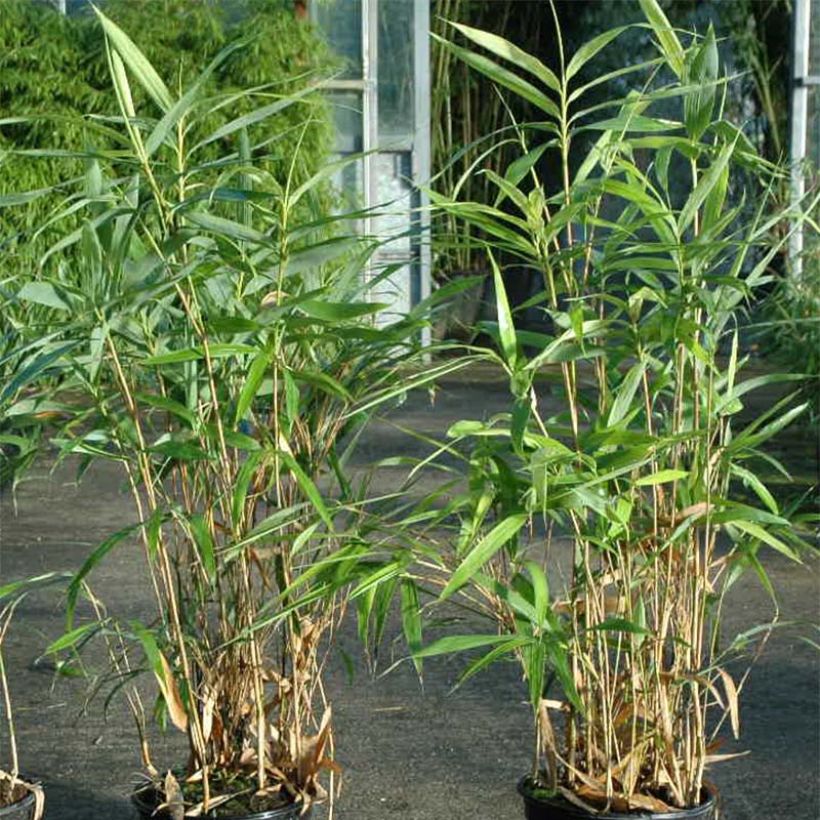

Plant habit
Foliage
Botanical data
Pseudosasa
japonica
Tsutsumiana
Poaceae
Arrow Bamboo
Cultivar or hybrid
Other Spreading Bamboo
Planting and care
When grown in containers, bamboos can be planted at any time of the year, except during frost. However, the best planting period is late summer and autumn, when the soil is warm and rainfall is more frequent. The planting distance depends on how you will use your bamboos: for a mass planting, allow a spacing of 1.8 to 2.2 metres (5 feet 11 inches to 7 feet 2 inches) between each young plant. For a hedge, this distance is reduced to 1 to 1.4 metres (3 feet 4 inches to 4 feet 7 inches).
In general, bamboos prefer rich, well-drained soil that remains moist, either acidic or neutral. They can tolerate slightly chalky soil. Pseudosasa japonica 'Tsutsumiana' does not tolerate direct sunlight well, so it should be planted in shade or partial shade. It is highly resistant to cold temperatures (up to -25°C (-13 °F)). This bamboo can adapt to any ordinary soil, even occasionally dry, as long as it is deep and well-drained.
During planting, do not hesitate to loosen the soil and thoroughly moisten the root ball by soaking it. You can add well-decomposed compost and lightly mix it into the surface. Watering should be done regularly, at least during the first year if planted in the ground, and constantly if your bamboos are grown in pots. The establishment period may seem a bit long at times, but don't panic!
For bamboos with spreading rhizomes, it is essential to install a rhizome barrier (thick and durable polypropylene film) because these varieties, which ignore property limits, can quickly colonize large areas. The rhizome barrier should be buried vertically, with a height of 10cm (3.9in) above the ground and inclined at a 15° (59 °F) angle towards the plant.
As for maintenance, bamboos are not demanding: remember to weed around the base, at least in the early stages, until the dead leaves form a natural mulch on the ground. A nitrogen-rich fertilizer (well-decomposed manure or liquid fertilizer) can be beneficial in spring and autumn.
Planting period
Intended location
Care
-
, onOrder confirmed
Reply from on Promesse de fleurs
Evergreen shrubs
Haven't found what you were looking for?
Hardiness is the lowest winter temperature a plant can endure without suffering serious damage or even dying. However, hardiness is affected by location (a sheltered area, such as a patio), protection (winter cover) and soil type (hardiness is improved by well-drained soil).

Photo Sharing Terms & Conditions
In order to encourage gardeners to interact and share their experiences, Promesse de fleurs offers various media enabling content to be uploaded onto its Site - in particular via the ‘Photo sharing’ module.
The User agrees to refrain from:
- Posting any content that is illegal, prejudicial, insulting, racist, inciteful to hatred, revisionist, contrary to public decency, that infringes on privacy or on the privacy rights of third parties, in particular the publicity rights of persons and goods, intellectual property rights, or the right to privacy.
- Submitting content on behalf of a third party;
- Impersonate the identity of a third party and/or publish any personal information about a third party;
In general, the User undertakes to refrain from any unethical behaviour.
All Content (in particular text, comments, files, images, photos, videos, creative works, etc.), which may be subject to property or intellectual property rights, image or other private rights, shall remain the property of the User, subject to the limited rights granted by the terms of the licence granted by Promesse de fleurs as stated below. Users are at liberty to publish or not to publish such Content on the Site, notably via the ‘Photo Sharing’ facility, and accept that this Content shall be made public and freely accessible, notably on the Internet.
Users further acknowledge, undertake to have ,and guarantee that they hold all necessary rights and permissions to publish such material on the Site, in particular with regard to the legislation in force pertaining to any privacy, property, intellectual property, image, or contractual rights, or rights of any other nature. By publishing such Content on the Site, Users acknowledge accepting full liability as publishers of the Content within the meaning of the law, and grant Promesse de fleurs, free of charge, an inclusive, worldwide licence for the said Content for the entire duration of its publication, including all reproduction, representation, up/downloading, displaying, performing, transmission, and storage rights.
Users also grant permission for their name to be linked to the Content and accept that this link may not always be made available.
By engaging in posting material, Users consent to their Content becoming automatically accessible on the Internet, in particular on other sites and/or blogs and/or web pages of the Promesse de fleurs site, including in particular social pages and the Promesse de fleurs catalogue.
Users may secure the removal of entrusted content free of charge by issuing a simple request via our contact form.
The flowering period indicated on our website applies to countries and regions located in USDA zone 8 (France, the United Kingdom, Ireland, the Netherlands, etc.)
It will vary according to where you live:
- In zones 9 to 10 (Italy, Spain, Greece, etc.), flowering will occur about 2 to 4 weeks earlier.
- In zones 6 to 7 (Germany, Poland, Slovenia, and lower mountainous regions), flowering will be delayed by 2 to 3 weeks.
- In zone 5 (Central Europe, Scandinavia), blooming will be delayed by 3 to 5 weeks.
In temperate climates, pruning of spring-flowering shrubs (forsythia, spireas, etc.) should be done just after flowering.
Pruning of summer-flowering shrubs (Indian Lilac, Perovskia, etc.) can be done in winter or spring.
In cold regions as well as with frost-sensitive plants, avoid pruning too early when severe frosts may still occur.
The planting period indicated on our website applies to countries and regions located in USDA zone 8 (France, United Kingdom, Ireland, Netherlands).
It will vary according to where you live:
- In Mediterranean zones (Marseille, Madrid, Milan, etc.), autumn and winter are the best planting periods.
- In continental zones (Strasbourg, Munich, Vienna, etc.), delay planting by 2 to 3 weeks in spring and bring it forward by 2 to 4 weeks in autumn.
- In mountainous regions (the Alps, Pyrenees, Carpathians, etc.), it is best to plant in late spring (May-June) or late summer (August-September).
The harvesting period indicated on our website applies to countries and regions in USDA zone 8 (France, England, Ireland, the Netherlands).
In colder areas (Scandinavia, Poland, Austria...) fruit and vegetable harvests are likely to be delayed by 3-4 weeks.
In warmer areas (Italy, Spain, Greece, etc.), harvesting will probably take place earlier, depending on weather conditions.
The sowing periods indicated on our website apply to countries and regions within USDA Zone 8 (France, UK, Ireland, Netherlands).
In colder areas (Scandinavia, Poland, Austria...), delay any outdoor sowing by 3-4 weeks, or sow under glass.
In warmer climes (Italy, Spain, Greece, etc.), bring outdoor sowing forward by a few weeks.

































